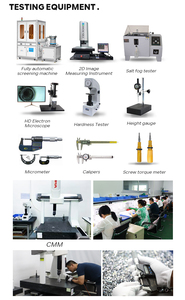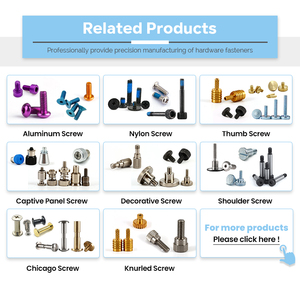
All categories
Featured selections
Trade Assurance
Buyer Central
Help Center
Get the app
Become a supplier

(2951 products available)


















































Bone plates and screws come in different types. They include:
Compression plates
These plates are primarily meant to provide stable bone fixation. They do this by applying compressive forces on the fractured bone sections. One way compression plates accomplish this is by having threaded screw holes that enable the screws to be driven at an angle. When the screws are tied, the plate gets pushed toward the bone. This action allows the fracture ends to be drawn together. In addition to stabilizing the bone, the compression plates also promote proper alignment. This, therefore, makes them commonly used in orthopedic surgeries where quick healing is paramount.
Tension band plates
Tension band plates convert tensile forces into compressive forces. They are especially useful in treating fracture types that occur in areas subject to high tensile stress. Such areas include the patella and the shoulder blades (scapula). A notable feature of these plates is that when installed, they allow normal tensions on one side of the bone to be converted into compressive forces across the fracture line. They do this by utilizing a combination of tension bands (often wires) and bone screws. As a result, these plates are able to realign and stabilize the fractured bone sections. Eventually, this enhances the healing process.
Locking plates
Locking plates are characterized by screws that can be locked into the plate. This creates a fixed-angle construct for better bone stabilization. Because of how they are designed, locking compression plates can provide stable fixation even in complex fractures that involve multiple fragments. Their ability to maintain proper fracture alignment irrespective of bone movement makes them suitable for use in surgeries involving low bone quality patients (e.g., elderly people suffering from osteoporosis). In addition, locking plates are increasingly becoming popular in veterinary orthopedic surgeries as well.
Neutralization plates
Neutralization plates are primarily meant to absorb the mechanical loads arising from fractures. They do not directly induce compression or have tension band mechanisms. Instead, these plates stabilize the bone by maintaining its proper alignment until the fracture is fully healed. Neutralization plates are especially ideal for situations where the bone can easily be weakened by excessive stress. Using such plates reduces the risk of screws and other related hardware failing or fracturing. Also, if an osteosynthesis plate is used, it can potentially hinder the healing process.
Fit plates
Fit plates are specially designed plates that contain specific geometries and contours to match the model of the bone where they will be applied. Such customizations are important for providing better stability as well as promoting more accurate fracture alignment. This is especially so for complex fractures that involve multiple bone anatomical features. Often, due to their high level of precision, fit plates are fabricated using advanced technologies like 3D printing. Although mainly used in reconstructive surgeries following trauma, fit plates are also used in corrective procedures for other bone-related conditions.
Bone screws and plates are formed from various materials. Here’s a breakdown:
Stainless steel
Stainless steel is the most commonly used material in making bone plates and screws. It is an alloy that contains steel, nickel, and chromium. The added chromium forms a protective layer that makes stainless steel resistant to corrosion. Because of this, stainless steel makes ideal hardware for orthopedic surgical applications. Its ability to withstand biological environments without rusting gives it durability. Additionally, stainless steel is known for its high tensile strength which allows it to easily bear mechanical loads. This, therefore, provides stability to the fractures during the healing process.
Titanium alloys
Titanium alloys are preferred options for bone plates and screws because of its exceptionally lightweight yet strong properties. Titanium is biocompatible. This means it won’t react with body tissues or cause adverse effects. As such, titanium alloy plates and screws are ideal for patients who have metal allergies or for those who will undergo postoperative procedures that require close monitoring. Besides, titanium exhibits flexibility that enables it to withstand the physiological stresses in the body without easily breaking or deforming. Its non-corrosive properties also ensure long-term stability within a surgical site and don't need to be retrieved after the healing process.
Polymer-based materials
Polymer-based materials, particularly medical-grade polymers like PEEK (polyether ether ketone) and PLA (polylactic acid), are increasingly becoming more popular in making bone plates. One of the advantages polymers come with is their lower density. This makes them lighter more so when compared to metals. While not as strong as metals, polymer plates offer flexibility. This accommodates the natural movement within the body. Polymeric materials are also useful alternatives for patients with metal sensitivities. Lastly, because of their radiolucent properties, polymer plates won’t interfere or cause disruptions with radiographic imaging.
Cobalt-chromium alloys
Cobalt-chromium alloys are primarily used to manufacture bone plates and screws that require more strength and corrosion resistance. These alloys are strong and this makes them ideal for high-load-bearing applications. The added chromium provides a corrosion-resistant surface. This accounts for its durability in the body’s fluid environment. While not as commonly used as titanium or stainless steel, cobalt-chromium implants are favored in specific orthopedic situations where longevity and mechanical strength are of paramount importance.
Resorbable metals
Resorbable metals, like magnesium and zinc alloys, are increasingly becoming popular in making bone plates and screws. These materials gradually dissolve within the body over time. This eliminates the need for a second surgery to remove the implant. Magnesium offers high strength while also being lightweight. This makes it ideal for low-load-bearing areas. Zinc, on the other hand, slows the resorption process down. This allows sustained support during the vital healing phase. Because of their biocompatibility and gradually diminishing mechanical support, resorbable metal implants are favored for their pioneer approaches in regenerative medicine.
Bone plates and screws have a myriad of applications. Here are some of them:
Internal fixation of fractures
Bone plates and screws are conventionally used to fix broken bones during surgeries. These implants provide stability at fracture sites and keep the bone pieces well aligned as the patient heals. Operating on complex fractures, especially those involving joints or multiple bone fragments, requires advanced techniques and equipment like compression plates. These plates and screws are critical to ensuring proper healing and restoring the bone’s normal function.
Bone plate osteosynthesis
Osteosynthesis is a surgical procedure in which bones are fixed using implants like plates and screws after fracture or injury. It can also involve the use of bone grafts to promote healing. Steel and titanium plates and screws are widely used in this process due to their strength, durability, and biocompatibility. The main aim is to ensure the integration of the implants with the bone. This provides long-term stability for whatever repair that was done.
Joint stabilization
In orthopedic surgeries involving damaged joints, bone plates and screws are used to stabilize the reconstruction. For instance, in Total Hip Arthroplasty, the acetabulum is plated to provide a stable environment for the healing bone. This application is especially prominent in repairing fractures around major joints like the knee, shoulder, and hip. Regardless of the complexity, fixation hardware always ensures proper alignment and stability, thus preserving the joint functionality.
Repair of deformities
Bones plates and screws are utilized in corrective surgeries meant to address skeletal deformities. Such cases may be due to a condition causing abnormal curvature (like scoliosis) or bone malalignment resulting from previous fractures. In these corrective procedures, Fit plates designed specifically for individual patients can provide more accurate alignment and stability. This helps restore normal bone shape and eventually improve the patient’s overall quality of life.
Veterinary orthopedics
Bone plates and screws are also widely used in veterinary medicine to treat fractures and bone deformities in animals. Just like in humans, these implants provide stability for complex fractures in pets. They also help correct skeletal deformities in companion animals and non-domestic ones. The most commonly used materials in these procedures are titanium and stainless steel due to their strength and corrosion resistance properties. Besides, veterinary orthopedists are also beginning to use locking plates and screws to treat mini fractures in small animal surgery.
Type
The type of necessary equipment depends on how complicated the patient’s fractures are. If a locking plate is needed to stabilize the fragments further, this should be readily available. Likewise, if a compression plate offers better stability, ensure it’s tightly secured too. Assessing these needs will help determine the most appropriate plates and screws for the surgery and improve the outcome.
Material
One should consider the various materials used for making the plates and screws. For instance, stainless steel offers excellent corrosion resistance and mechanical strength, hence its wide usage. Titanium, on the other hand, is lighter and highly biocompatible. This makes it ideal for patients with a metal allergy or who will be undergoing future medical procedures. There are also absorbable implants that may be suitable in specific cases. Weighing the advantages and disadvantages of each will help settle on the most appropriate material for the surgery at hand.
Plate design
The design of the bone plate, such as its contour and design, significantly impacts the plate’s functionality. Anatomical fit plates are specifically designed to match the bone’s natural form. This provides better stabilization, especially for complex fractures. Besides, devices like perforated plates may offer more flexibility when needed in areas where bone is still developing. Assessing the plate design in relation to the patient’s surgical needs will ensure optimal stability and promote better outcomes.
Patient’s status
The type of plate and screw to go for may also depend on the patient’s bone density and overall health. For instance, in elderly patients with weakened bones, locking plates may be more suitable. These provide stable fixation with minimal movement. Conversely, in younger patients with healthy bones, compression plates may be favored. They allow dynamic healing. Evaluating the patient’s condition will help one choose implants that will cater to their specific needs and enhance surgical success.
Bone plates and screws are commonly used in pediatric orthopedics. Surgeons take special measurements when performing these procedures. This ensures the plates and screws are proportionate to the smaller bones in a child’s body. In relation to the child’s growth, care is also taken to avoid any interference with the growth plates. This ensures the future bone development is not adversely affected.
The duration for which bone plates and screws stay in the body varies depending on factors like the type of fracture and the patient’s healing process. Usually, these implants remain in the body until the bone has fully healed. In most cases, this takes about 6 to 12 months. There are also cases where plates and screws made of resorbable materials are used. These implants gradually dissolve over time. They typically do within 6 to 12 weeks. This eliminated the need for second surgeries altogether.
Yes, but not all. Security staff at airports are always informed about the presence of implants in a person’s body. There are also specific metal detectors designed for this kind of hardware, which often cause minimal disruptions. Moreover, plates and screws made of titanium are highly favored in patients with implants due to their low density and high strength. They cause less interference. Bone plates and screws are also increasingly being made from advanced materials like PEEK. It’s a radiolucent polymer that won’t interfere with medical imaging either.
Bone plates and screws do not require any special maintenance. After surgery, patients are typically advised to follow regular post-operative care routines for recovery. This may include keeping the surgical site clean and dry and attending follow-up appointments for monitoring the healing process. More importantly, any implanted hardware like plates and screws doesn’t need to be separately maintained. The body itself naturally accommodates them as they integrate into the bone over time.